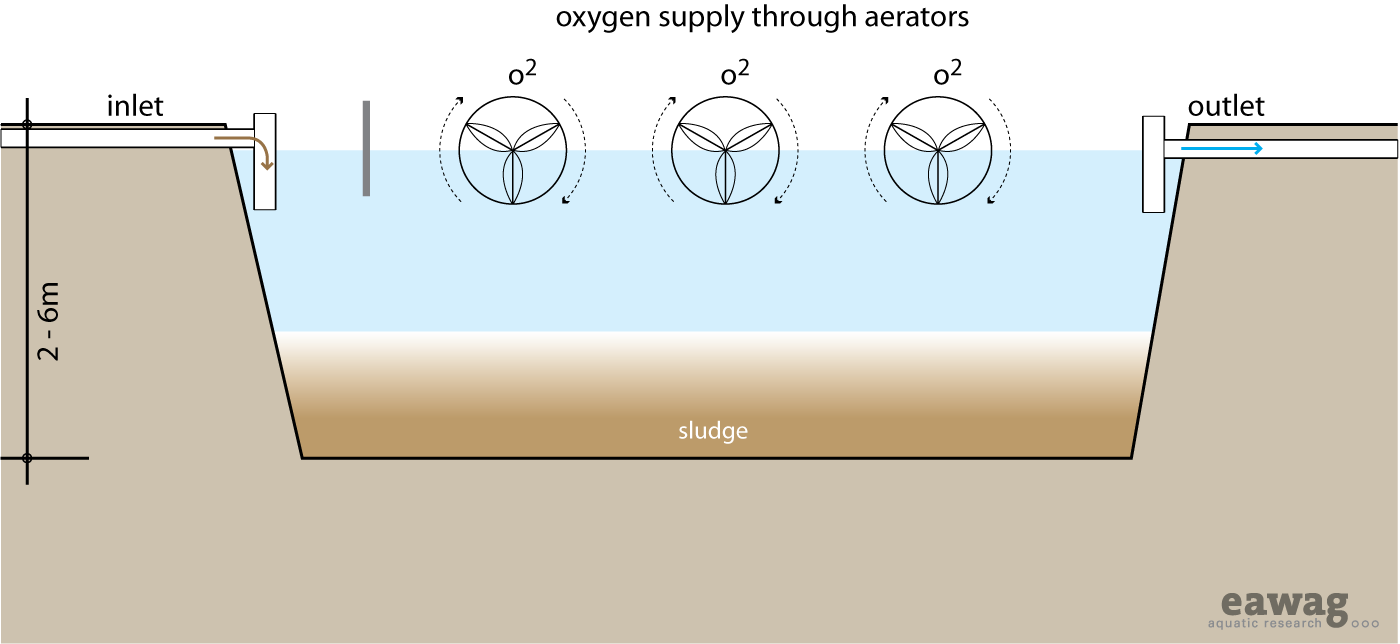Aerated Pond
|

|
|
| |||||||||||||||||||||||||||||||
An Aerated Pond is a large, outdoor, mixed aerobic reactor.Mechanical aerators provide oxygen and keep the aerobic organisms suspended andmixed with the water to achieve a high rate of organic degradation and nutrient removal.
Increased mixing and aeration from the mechanical units means that the ponds can be deeper and can tolerate much higher organic loads than a maturation pond. The increased aeration allows for increased degradation and increased pathogen removal. As well, because oxygen is introduced by the mechanical units and not by light-driven photosynthesis, the ponds can function in more northern climates. Influent should be screened and pre-treated to remove garbage and coarse particles that could interfere with the aerators. Because the aeration units mix the pond, a subsequent settling tank is required to separate the effluent from the solids.
The smaller area requirement (compared to a maturation pond) means that it is appropriate for both rural, and peri-urban environments.
The pond should be built to a depth of 2 to 5m and should have a detention time of 3 to 20 days. To prevent leaching, the pond should have a liner. The liner can be clay, asphalt, compacted earth, or another impervious material. Using the fill that is excavated, a protective berm should be built around the pond to protect it from runoff and erosion.
| Advantages | Disadvantages/limitations |
|---|---|
| - Good resistance against shock loading. - High reduction in pathogens. - Construction can provide short-term employment to local labourers. - Requires large land area. - Long service life. - No real problems with insects or odours if designed correctly. |
- Effluent/sludge requires secondary treatment and/or appropriate discharge. - Requires expert design and construction supervision. - Requires full time operation and maintenance by skilled personnel. - Not all parts and materials may be available locally. - Constant source of electricity is required. - Moderate-high capital and variable operating costs depending on the price of land, electricity. |
Adequacy
A mechanically aerated pond can efficiently handle high concentration influent and can reduce pathogen levels significantly. It is especially important that electricity service is uninterrupted and that replacement parts are available to prevent extended downtimes that may cause the pond to turn anaerobic. Aerated lagoons can function in a larger range of climates than WSPs. They are most appropriate for regions with large areas of inexpensive lands that are away from homes and businesses.
Health Aspects/Acceptance
The pond is a large expanse of pathogenic wastewater; care must be taken to ensure that no one comes in contact with, or goes into the water. The aeration units can be dangerous to humans and animals. Fences, signage, or other measures should be taken to prevent entry to the area.
Maintenance
A permanent skilled staff is required to repair and maintain aeration machinery. The pond must be desludged once every 2 to 5 years. Care should be taken to ensure that the pond is not used as a garbage dump, especially considering the damage that could be done to the aeration equipment.
References
- Elizabeth Tilley et.al (2008). Compendium of Sanitation Systems and Technologies (low res version). Department of Water and Sanitation in Development Countries (Sandec) at the Swiss Federal Institute of Aquatic Science and Technology (Eawag). (Provides a full overview of sanitation systems.)
- Arthur, JP. (1983). Notes on the Design and Operation of Waste Stabilization Ponds in Warm Climates of Developing Countries. The World Bank + UNDP, Washington. (Notes on applicability and effectiveness.)
- Crites, R. and Tchobanoglous, G. (1998). Small and Decentralized Wastewater Management Systems. WCB and McGraw-Hill, New York, USA. pp 527–558. (Comprehensive summary chapter.)
- Tchobanoglous, G., Burton, FL. and Stensel, HD. (2003). Wastewater Engineering: Treatment and Reuse, 4th Edition. Metcalf & Eddy, New York. pp 840–85. (Detailed design and example problems.)
